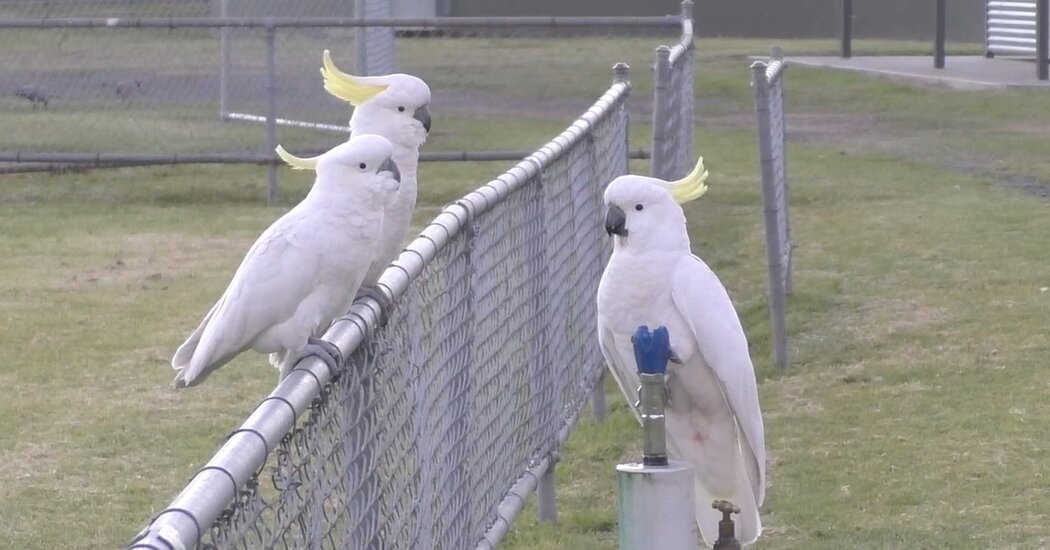Most birds go for ease when looking for drinking water. But the sulfur-crested cockatoos in the suburbs of Sydney, Australia, often prefer to quench their thirst with a challenging puzzle.
In the city’s western suburbs, some of the birds have figured out how to use public drinking fountains. The mohawked parrots deftly use one foot to twist the handle open while their other claw grips the spout.
It’s unclear why the cockatoos go to the effort of using drinking fountains when there are plenty of accessible water sources nearby. They don’t seem to use them more often during hot weather.
One possible explanation is that the task of operating the fountains is simply more fun than sipping water from the local creeks.
“If there is no super urgent need and you’re not dying of thirst, then why not do something you enjoy?” said Barbara C. Klump, an author of a study of the birds published on Wednesday in the journal Biology Letters, and a behavioral ecologist at the Max Planck Institute of Animal Behavior in Germany.
It’s not the first time cockatoos in this area of Australia have been seen cleverly manipulating urban objects for their own benefit. Dr. Klump and her colleagues have also tracked the birds flipping open garbage bins across greater Sydney, a socially learned behavior that has resulted in an arms race (or maybe a wing race) with human residents.
“These birds do seem to be thriving in city settings,” said Kevin McGraw, a behavioral ecologist at Michigan State University who was not involved in the paper. He said that could be explained by their ability to adapt to their urban and suburban environments.
Dr. Klump first spotted cockatoos drinking from public bubblers during field research for another project in 2018. At first, she thought someone had forgotten to turn the tap off. But video footage revealed one bird grabbing the spring-loaded handle with its foot to activate the trickling water. Local wildlife officials told Dr. Klump that the cockatoos in the area had been doing so for years.
“Then, of course, a million questions went through my mind,” Dr. Klump said. One of them was “how the hell did it figure that out?” she said.
To find out, Dr. Klump and her colleagues tagged 24 birds from a population of as many as 150 living in a reserve in Western Sydney. They installed cameras in front of drinking fountains to catch the birds in action.
The cockatoos attempted to use the drinking fountains more than 500 times during 44 days of footage. Some 70 percent of the tagged birds tried using the bubblers, a hint they had probably been engaging in the behavior for some time. But less than half of the cockatoos were successful, suggesting the activity requires a complex sequence of motor skills that are tricky to master. Similar to the way humans pick up new skills, the cockatoos probably developed their fountain-hacking talents through a mix of watching one another and individual experimentation, Dr. Klump said.
While male cockatoos were better at flipping open heavy garbage-bin lids than females in earlier studies, both sexes were equally adept at operating the drinking fountains.
The cockatoos used the drinking fountains at similar times each day, regardless of the weather. This suggests the birds are using them as a regular water source rather than just a backup when conditions are tough.
And although the behavior hasn’t spread across multiple suburbs like the bin-opening trend has, Lucy Aplin, a behavioral ecologist at Australian National University and a co-author of the study, said residents in Brisbane have spotted cockatoos using drinking fountains there, too. Because the birds don’t migrate, the Brisbane birds couldn’t have learned from the Sydney flock. That suggests there’s potential for the “independent invention of the behavior and local spread in other places,” Dr. Aplin said.
Andrea Griffin, a behavioral ecologist at the University of Newcastle in Australia who wasn’t involved in the study, said she was not surprised that cockatoos have learned to operate drinking fountains. Their motor skills, attraction to novelty and ability to watch and learn from one another make them natural innovators. “There are a lot of parameters that would favor innovations in a species like this,” Dr. Griffin said.
Dr. Klump and her colleagues are taking a closer look at the behavior, such as how long it takes the cockatoos to master the skill. The researchers are also curious to know what the cockatoos will do next.
“I’d love to learn more about what else they have up their sleeves,” Dr. Klump said.
